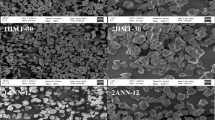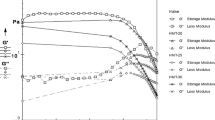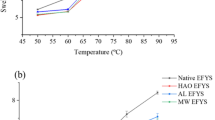Abstract
The objective of this study was to study and compare the impact of HMT on rheology and textural properties observed between sago and arenga starces, and then related to structural change of amylopectin. The HMT were conducted using the autoclaving method at 20% moisture content and heated to 120 C for 60 min for sago and 90 min for arenga starch as optimum condition. The HMT shifted gelatinization temperature higher and reduced the enthalpy of both starches. The HMT sago starch paste exhibited an exceptionally strong shear thinning behavior as shown by a rapid decrease of viscosity and an increase of shear rate. The HMT clearly made the texture of starch gels more fragile compared to their native form and reduced their breaking point to a lower strain. The HMT effect on the rheological properties and texture of the sago starch was greater than the changes observed with the arenga starch. Major changes in rheological properties after HMT was not followed by changes in amylopectin structure. The HMT process did not significantly affect the amylopectin chain-length distribution in Arenga starch. In the sago starch, HMT affect to long chain amylopectin with DP ≥ 37. The HMT effect on rheology and textural properties was higher in sago starch than arenga starch. This study demonstrated that long chain amylopectin with DP ≥ 37 plays an important role in contributing to the rheological change caused by the HMT.




Similar content being viewed by others
References
Adawiyah DR, Sasaki T, Kohyama K (2013) Characterization of arenga starch in comparison with sago starch. Carbohyd Polym 92:2306–2313
Adebowale KO, Henle T, Schwarzenbolz U, Doert T (2009) Modification and properties of African yam bean (Sphenostylis stenocarpa Hochst. Ex A. Rich) Harms starch I: heat moisture treatment and annealing. Food Hydrocolloids 23:1947–1957
Akuzawa S, Kawabata A (2003) Relationship among starch from different origins classified according to their physicochemical properties. J Appl Glycosci 50:121–126
Bertoft E, Annor GA, Shen X, Rumpagaporn P, Seetharaman L, Hamaker BR (2016) Small differences in amylopectin fine structure may explain large functional differences of starch. Carbohyd Polym 140:113–121
Biliaderis CG (1990) Thermal analysis of food carbohydrates. In: Harwalkar VR, Ma CY (eds) Thermal analysis of foods. Elsevier, London, pp 168–213
Chung HJ, Hoover R, Liu Q (2009) The impact of single and dual hydrothermal modification on the molecular structure and physicochemical properties of normal corn starch. Int J Biol Macromol 44:203–210
Gunaratne A, Hoover R (2002) Effect of heat-moisture treatment on the structure and physicochemical properties of tuber and root starches. Carbohyd Polym 49:425–437
Hoover R, Manuel H (1996) Effect of heat-moisture treatment on the structure and physicochemical properties of normal maize, waxy maize, dull waxy maize and amylomaize V starches. J Cereal Sci 23:153–162
Hormdok R, Noomhorn A (2007) Hydrothermal treatments of rice starch for improvement of rice noodle quality. LWT 40:1723–1731
Ikeda S, Nishinari K (2001) Weak gel type rheological properties of aqueous dispersions of non-aggregated k-carrageenan helices. J Agric Chem 49:4436
Jane J, Chen YY, Lee LF, Mcpherson AE, Wong KS, Radosavljevic M, Kasemsuwan T (1999) Effect of amylopectin branch chain length and amylose content on the gelatinization and pasting properties of starch. Cereal Chem 76(5):629-637
Koizumi K, Fukuda M, Hizukuri S (1991) Estimation of the distribution of chain length of amylopectins by high-performance liquid chromatography with pulsed amperometric detection. J Chromatogr 585:233–238
Li S, Ward R, Gao Q (2011) Effect of heat moisture treatment of the formation and physicochemical properties of resistant starch from mung bean (Phaseolus radiates) starch. Food Hydrocolloids 25:1702–1709
Miyazaki M, Morita N (2005) Effect of heat moisture treated maize starch on the properties of dough and bread. Food Res Int 38:369-376
Nishinari K (2009) Some thought on the definition of gel. Prog Colloid Polym Sci 136:87–94
Pukkahuta C, Varavinit S (2007) Structural transformation of sago starch by heat moisture treatment and osmotic-pressure treatment. Starch 59:624–631
Purwani EY, Widaningrum, Thahir R, Muslich (2006) Effect of heat moisture treatment of sago starch on its noodle quality. Indones J Agric Sci 7:8–14
Sui Z, Yao T, Zao Y, Ye X, Kong X, Ai L (2015) Effect of heat-posture treatment reaction condition on the physicochemical and structural properties of maize starch: moisture and length of heating. Food Chem 173:1125–1132
Takaya T, Sano C, Nishinari K (2000) Thermal studies on the gelatinization and retrogradation of heat-moisture treated starch. Carbohyd Polym 41:97–100
Teng LY, Chin NL, Yusof YA (2011) Rheological and textural studes of fresh and freeze-thawed native sago starch-sugar gels. I. Optimisation using response surface methodology. Food Hydrocoll 6:1530–1537
Varatharajan V, Hoover R, Seetharaman K (2010) The impact of heat moisture treatment on the molecular structure and physicochemical properties of normal and waxy potato starches. Carbohyd Polym 81:466–475
Zavarese ER, Dias ARG (2011) Impact of heat moisture treatment and annealing in starches: a review. Carbohyd Polym 83:317–328
Acknowledgement
This research was supported by UNU-KIRIN fellowship programe.
Author information
Authors and Affiliations
Corresponding author
Rights and permissions
About this article
Cite this article
Adawiyah, D.R., Akuzawa, S., Sasaki, T. et al. A comparison of the effects of heat moisture treatment (HMT) on rheological properties and amylopectin structure in sago (Metroxylon sago) and arenga (Arenga pinnata) starches. J Food Sci Technol 54, 3404–3410 (2017). https://doi.org/10.1007/s13197-017-2787-1
Accepted:
Published:
Issue Date:
DOI: https://doi.org/10.1007/s13197-017-2787-1




